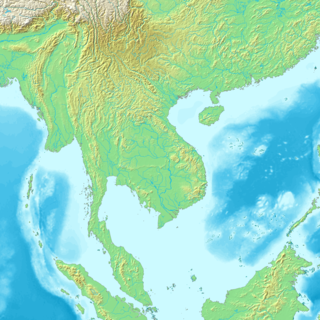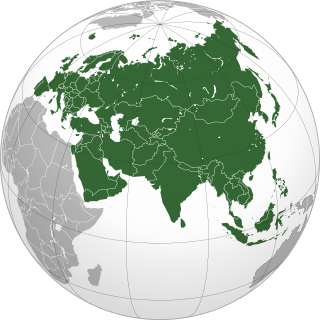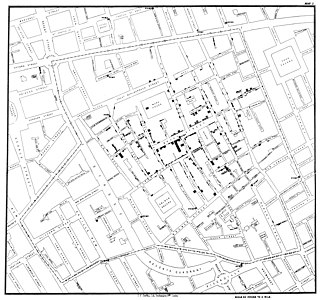
Asia is Earth's largest and most populous continent, located primarily in the Eastern and Northern Hemispheres. It shares the continental landmass of Eurasia with the continent of Europe and the continental landmass of Afro-Eurasia with both Europe and Africa. Asia covers an area of 44,579,000 square kilometres (17,212,000 sq mi), about 30% of Earth's total land area and 8.7% of the Earth's total surface area. The continent, which has long been home to the majority of the human population, was the site of many of the first civilizations. Asia is notable for not only its overall large size and population, but also dense and large settlements, as well as vast barely populated regions. Its 4.5 billion people constitute roughly 60% of the world's population.

Political ecology is the study of the relationships between political, economic and social factors with environmental issues and changes. Political ecology differs from apolitical ecological studies by politicizing environmental issues and phenomena.

Mainland Southeast Asia is the continental portion of Southeast Asia. It lies east of the Indian subcontinent and south of China and is bordered by the Indian Ocean to the west and the Pacific Ocean to the east. It includes the countries of Myanmar (Burma), Thailand, peninsular Malaysia, Laos, Cambodia and Vietnam.
In geography, regions are areas that are broadly divided by physical characteristics, human impact characteristics, and the interaction of humanity and the environment. Geographic regions and sub-regions are mostly described by their imprecisely defined, and sometimes transitory boundaries, except in human geography, where jurisdiction areas such as national borders are defined in law.

Guns, Germs, and Steel: The Fates of Human Societies is a 1997 transdisciplinary non-fiction book by Jared Diamond, professor of geography and physiology at the University of California, Los Angeles (UCLA). In 1998, Guns, Germs, and Steel won the Pulitzer Prize for general nonfiction and the Aventis Prize for Best Science Book. A documentary based on the book, and produced by the National Geographic Society, was broadcast on PBS in July 2005.

The Han Chinese, Hanzu, Han people, are an East Asian ethnic group and nation native to China. They constitute the world's largest ethnic group, making up about 18% of the global population. The estimated 1.3 billion Han Chinese people are mostly concentrated in mainland China and in Taiwan. Han Chinese people also make up three quarters of the total population of Singapore.
Geopolitics is the study of the effects of Earth's geography on politics and international relations. While geopolitics usually refers to countries and relations between them, it may also focus on two other kinds of states: de facto independent states with limited international recognition and; relations between sub-national geopolitical entities, such as the federated states that make up a federation, confederation or a quasi-federal system.

A dispute exists over the international name for the body of water which is bordered by Japan, Korea and Russia. In 1992, objections to the name Sea of Japan were first raised by North Korea and South Korea at the Sixth United Nations Conference on the Standardization of Geographical Names. The Japanese government supports the exclusive use of the name "Sea of Japan" (日本海), while South Korea supports the alternative name "East Sea", and North Korea supports the name "Korean East Sea". Currently, most international maps and documents use either the name Sea of Japan exclusively, and far fewer maps include both the name Sea of Japan and East Sea, often with East Sea listed in parentheses or otherwise marked as a secondary name. The International Hydrographic Organization, the international governing body for the naming of bodies of water around the world, in 2012 decided not to change the current single name "Sea of Japan" rejecting South Korea's request to use "East Sea" together with "Sea of Japan".

A home, or domicile, is a living space used as a permanent or semi-permanent residence for an individual, family, household or several families in a tribe. It is often a house, apartment, or other building, or alternatively a mobile home, houseboat, yurt or any other portable shelter. A principle of constitutional law in many countries, related to the right to privacy enshrined in article 12 of the Universal Declaration of Human Rights is the inviolability of the home as an individual's place of shelter and refuge.

Golden Spike National Historical Park is a U.S. National Historical Park located at Promontory Summit, north of the Great Salt Lake in east-central Box Elder County, Utah, United States. The nearest city is Corinne, approximately 23 miles (37 km) east-southeast of the site.
This page is a list of geography topics.

Yi-Fu Tuan is a Chinese-American geographer. He is one of the key figures in human geography and arguably the most important originator of humanistic geography.

The history of geography includes many histories of geography which have differed over time and between different cultural and political groups. In more recent developments, geography has become a distinct academic discipline. 'Geography' derives from the Greek γεωγραφία – geographia, a literal translation of which would be "to describe or write about the Earth". The first person to use the word "geography" was Eratosthenes. However, there is evidence for recognizable practices of geography, such as cartography prior to the use of the term geography.

The Hominini, or hominins, form a taxonomic tribe of the subfamily Homininae ("hominines"). Hominini includes the genus Homo (humans), but excludes the genus Gorilla (gorillas). As of 2019, there is no consensus on whether it should include the genus Pan, the question being closely tied to the complex speciation process connecting humans and chimpanzees and the development of bipedalism in proto-humans.

History is the study of the past as it is described in written documents. Events occurring before written record are considered prehistory. It is an umbrella term that relates to past events as well as the memory, discovery, collection, organization, presentation, and interpretation of information about these events. Scholars who write about history are called historians.

East Asia is the eastern subregion of Asia, defined in either geographical or ethno-cultural terms. China, Japan, Korea, and Vietnam belong to the East Asian cultural sphere. Geographically and geopolitically, the region includes China, Hong Kong, Macau, Taiwan, Japan, Mongolia, North Korea, and South Korea.

Eurasia is the combined continental landmass of Europe and Asia. The term is a portmanteau of its constituent continents. Located primarily in the Northern and Eastern Hemispheres, it is bordered by the Atlantic Ocean to the west, the Pacific Ocean to the east, the Arctic Ocean to the north, and by Africa, the Mediterranean Sea, and the Indian Ocean to the south. The division between Europe and Asia as two different continents is a historical social construct, with no clear physical separation between them; thus, in some parts of the world, Eurasia is recognized as the largest of the six, five, or even four continents on Earth. In geology, Eurasia is often considered as a single rigid megablock. However, the rigidity of Eurasia is debated based on paleomagnetic data.



















